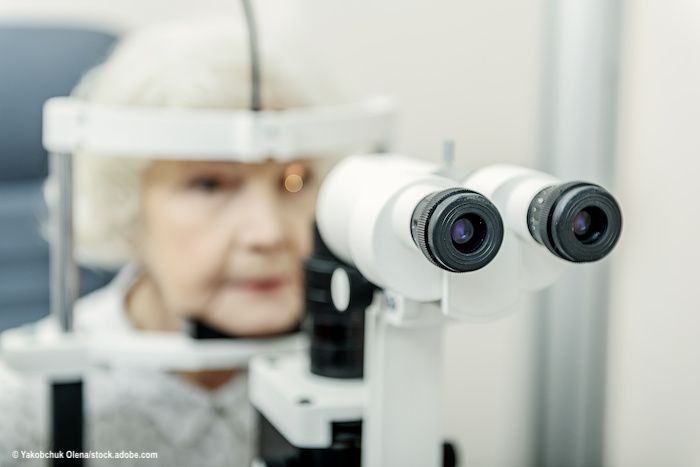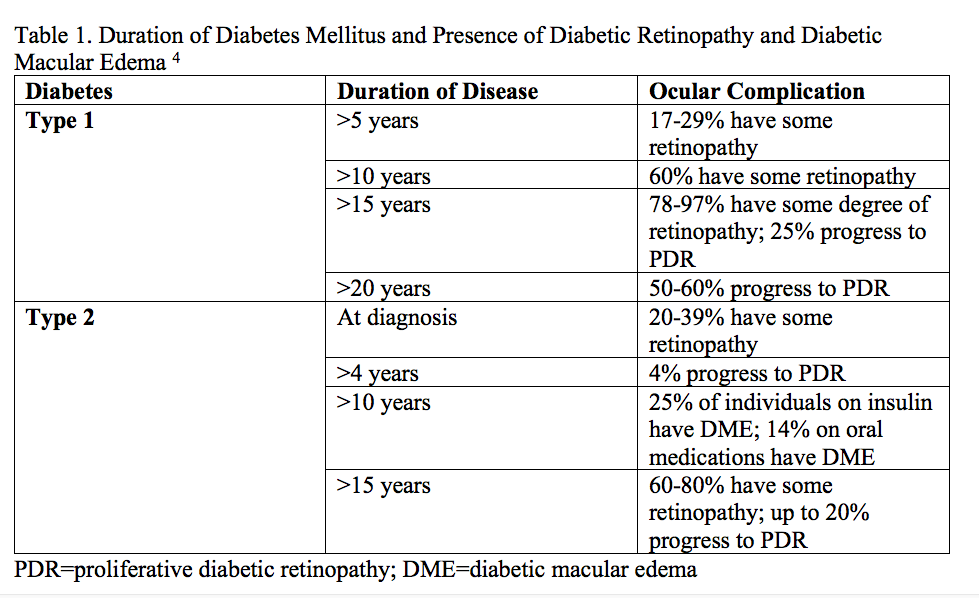Risk factors and recommendations for DR, DME

Duration of Diabetes Mellitus and Presence of Diabetic Retinopathy and Diabetic Macular Edema

According to a 2018 American Eye-Q Survey conducted by the American Optometric Association (AOA), nearly half of Americans didn't know whether diabetic eye diseases have visible symptoms.1 The same survey found that more than one-third of Americans didn't know a comprehensive eye exam is the only way to determine if a person's diabetes will cause blindness.
The World Health Organization2 says the number of people with diabetes has increased from 108 million in 1980 to 422 million in 2014; 2.6% of global blindness can be attributed to diabetes. The group also advocates screening and treatment for retinopathy as a cost saving intervention. In Global Report on Diabetes,3 the WHO said type 1 diabetes is the result of complex interaction between genes and environmental factors, while the risk for type 2 diabetes is determined by an interplay of genetic and metabolic factors.
Specifically, the report noted ethnicity, family history of diabetes, and previous gestational diabetes combined with older age, weight, unhealthy diet, physical inactivity, and smoking increases the risk. The AOA notes that specific risk factors for type 1 diabetes are unclear, but family history, viral exposure (e.g., Epstein-Barr virus), or autoimmune disorders may play a role.4
Furthermore, based on cost estimates from a recent systematic review, it has been estimated that the direct annual cost of diabetes to the world is more than US$827 billion.3 The International Diabetes Federation estimates that total global health-care spending on diabetes more than tripled over the period 2003 to 2013 – the result of increases in the number of people with diabetes and increases in per capita diabetes spending.3
Prevent Blindness America has estimated more than 7.6 million people in the U.S. have DR as a result of their systemic disorder.5 It is further estimated that 20-40% of people with type 2 diabetes already have DR at the time of their initial diabetes diagnosis.6,7 The AOA predicts as many as 429 million people will have diabetes worldwide by 2030; the group notes that about 79 million American adults older than 20 currently have pre-diabetes, too.4
Both the American Diabetes Association (ADA) and the American Academy of Ophthalmology (AAO) recommend yearly eye exams; initial screening within 5 years of diagnosis if type 1 diabetes is confirmed, and annually for both types 1 and 2.8 Yet only 60% of patients with diabetes are screened annually for DR,9 even though primary care physicians have improved the number of patients they now refer to eye-care specialists for funduscopic exams.10,11
In Table 1, the AOA summarized the estimated proportion of people with DR and DME by type and diabetes duration. The prevalence of people with diabetes (diagnosed or undiagnosed) is around 27% in people 65 years or older, 10% of non-Hispanic whites older than 20 years of age, and 19% of non-Hispanic blacks older than 20 years of age.
Because there is an acute onset of symptoms for people with type 1 (typically following hyperglycemia), clinical testing for antibodies related to type 1 is not recommended as a means to identify people at risk; the ADA does recommend that all people over the age of 45 be screened, however.
References:
1. Diabetic Retinopathy. Available at: https://www.aoa.org/patients-and-public/eye-and-vision-problems/glossary-of-eye-and-vision-conditions/diabetic-retinopathy Accessed October 15, 2019. St. Louis, MO: American Optometric Association, 2019.
2. World Health Organization. Diabetes Fact Sheet. https://www.who.int/news-room/fact-sheets/detail/diabetes. Accessed October 26, 2019. Geneva, Switzerland: WHO, 2019.
3. World Health Organization. Global Report on Diabetes. Geneva, Switzerland: WHO, 2016.
4. American Optometric Association. Eye Care of the Patient with Diabetes Mellitus: Evidence-Based Clinical Practice Guideline. Optometric Clinical Practice Guideline. Available from: http://www.aoa.org/Documents/EBO/EyeCareOfThePatientWithDiabetesMellitus%20CPG3.pdf. Accessed October 15, 2019. St. Louis, MO: American Optometric Association, 2014.
5. Prevent Blindness America. Vision Problems in the U.S. Prevalence of Adult Vision Impairment and Age-Related Eye Disease in America. Accessed June 20, 2012. Chicago, IL: Prevent Blindness, 2012.
6. Harris MI, Klein R, Welborn TA, Knuiman MW. Onset of NIDDM occurs at least 4-7 yr before clinical diagnosis. Diabetes Care 1992;15(7):815-9.
7. Kohner EM, Aldington SJ, Stratton IM, et al. United Kingdom Prospective Diabetes Study, 30: diabetic retinopathy at diagnosis of non-insulin-dependent diabetes mellitus and associated risk factors. Arch Ophthalmol 1998;116(3):297-303.
8. American Diabetes Association. Executive summary: Standards of medical care in diabetes--2013. Diabetes Care 2013;36 Suppl 1:S4-10.
9. American Academy of Ophthalmology Retina Panel. Preferred Practice Pattern Guidelines: Diabetic Retinopathy. San Francisco, CA: 2016.
10. Yung CW, Boyer MM, Marrero DG, Gavin TC. Patterns of diabetic eye care by primary care physicians in the state of Indiana. Ophthalmic Epidemiol 1995;2(2):85-91.
11. Ozerov I, Monderer R. Diabetic retinopathy: Examination and referral practices of primary care providers. Einstein Quart J Biol Med 2001;18:164-70.
Newsletter
Keep your retina practice on the forefront—subscribe for expert analysis and emerging trends in retinal disease management.